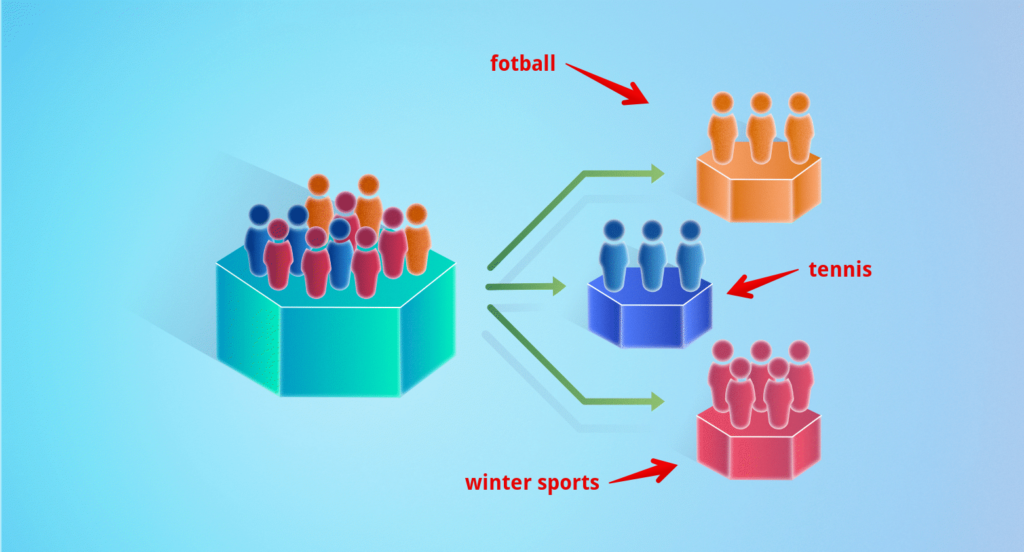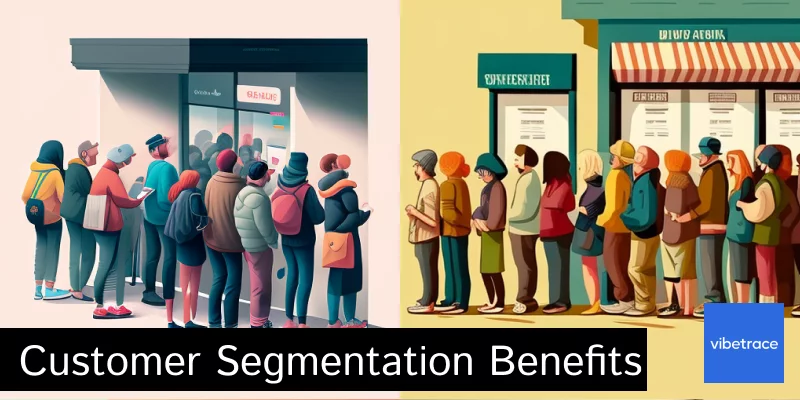Customer segmentation refers to segregating customers into groups on the basis of specific characteristics or behaviors.
For instance, a business-to-consumer company may divide its shoppers based on age, gender, marital status, location, and life stage, among other characteristics.
This initiative allows businesses to create tailored marketing campaigns for each audience cluster.
For example, a skincare brand may segment its customers by age and launch a marketing campaign on TikTok for Gen-Zers, as 41% of this population is reported to allocate most of their budget to skincare products, and 46% of this age group uses the platform daily.

Customer segmentation is essential for online retailers, as it impacts business growth, ROI, customer loyalty, and more. This process allows stores to target the most suitable audience by studying purchase behavior.
In this guide, you’ll learn about the types of ecommerce customer segments and how they can benefit your business.
Benefits of Customer Segmentation
Customer segmentation is a cost-effective approach that allows businesses to understand the individual preferences of each market demographic. This method empowers brands to connect with prospective and existing customers using data-driven strategies.
For example, you may target Gen-Z by creating trending advertisements on popular social platforms like TikTok. How does that benefit you as an ecommerce business owner? Well, it can help you accomplish the following:
Increased Conversion Rate Through Personalization
With marketing segmentation, you can deliver personalized messages to a specific audience.
For example, if your customers include a large segment of Hispanics and Latin Americans, you can run ads in Spanish for that particular division. This will help you connect better with the target customers, ultimately increasing conversions.

In fact, according to Adobe research report, 61% of Americans consider diversity as a critical factor in advertisements. Moreover, 38% of customers are more inclined to purchase from brands that promote diversity.
Therefore, personalization in advertisements, marketing, and brand promotion can be critical in improving your conversion rate.
Personalization can be achieved using:
- dynamic content for site
- product recommendations
Our software can help you with those automatically by analyzing customer behaviour and display smart campaigns according to user interests and profile.

Improved Targeting For Marketing Campaigns
As an online retailer continuously improving your products, you will be able to market yourself better through customer segmentation.
You can specify who you are targeting and create more focused marketing messages. You’ll reach only the people looking for a product like yours.
Segmenting your clientele allows you to see the kinds of groups present and their unique requirements, helping you to divide and conquer appropriately.
You won’t need to take a broad marketing approach and wait for something to land. Instead, you’ll be able to craft a particular image, making you more memorable for users.
Increased ROI
Segmenting your market into separate customer groups helps minimize the risk of business failure.
This is because you’ll be able to determine the ideal way to deliver your products to the target market, subsequently gaining a significant market share.
Due to this, you can increase your efficiency and direct your resources to the efforts producing a good ROI.
Increase Customer Retention
Though gaining new customers is good for any ecommerce retailer, the best practice is prioritizing existing customers over new ones.

This is because 75% of satisfied clients are likelier to become loyal customers of a business regularly meeting their needs.
But how can you do this through customer segmentation? Well, when you segment customers according to their value, you’ll be able to retain them more easily with targeted campaigns and strategies.
For instance, you can split customers from least to most loyal according to their specific attributes.
Through this, you can focus your efforts on those who are likely to be loyal, as they have the highest chances of buying from you again. As a result, they’ll promote your brand and recommend you to friends.
Do you like this article?
Join our CX for Retail dedicated newsletter!

Stay connected to what’s really important to optimize your digital revenues.
By clicking the button, you accept our Terms & Conditions. Also you will need to confirm your email address.
Examples of Customer Segmentation
Customer segmentation can be done in a variety of ways, but for ecommerce businesses, these segments are mostly considered:
Demographic Segmentation
The most common method to segment your market is through demographic segmentation. It is basically creating segments according to demographics, such as occupation, age, race, gender, education, and income, among others. In this approach, it is assumed that individuals from the same population will have comparable needs.
An example of this would be:
Let’s say your online store sells video game consoles. When employing this type of segmentation, you’ll discover that the primary market for this product includes young adult males with disposable income.
Behavioral Segmentation
With behavioral segmentation, you’ll be relying heavily on consumer actions, decision-making patterns, and overall browsing data of the market.
In this approach, customers are grouped according to how they have previously interacted with products and markets.

You will be assuming the kind of products consumers will buy in the future are in line with what they’ve purchased in the past. However, it is important to remember that people’s spending habits can change according to global happenings and the passage of time.
Behavioural Segmentation is a must tactic to use for marketing automation communication. This can be done using automation workflows or repetitive campaigns.
An example of this would be:
If your ecommerce store is selling different types of beer, consumers from older generations generally buy nationally-recognized brands, while millennials tend to buy craft beer.
Psychographic Segmentation
Psychographic segmentation entails classifying consumers according to peoples’ lifestyles, interests, opinions, and personalities. It can be harder to segment customers in this way as people evolve over time, and obtaining objective data on this isn’t easy.
But, it can be the strongest segmentation strategy as the individuals are grouped according to intrinsic motivators compared to external information.
An example of this would be:
If you’re an online fitness apparel retailer, you can target segments who love watching or playing different sports.

Prediction segmentation
With prediction segmentation, you’re leveraging machine learning to analyze customer data and understand how combinations of different attributes correlate to your business goals.
Through this system, you automatically segment groups according to determined interests, churn risk, propensity to purchase, and more. This allows you to predict how groups are likely to behave and interact with your brand in the future.
Segmentation Benefits Conclusion
Ecommerce businesses usually adopt a standardized marketing strategy that fails to attract new and existing customers. To gain profits and retain customers, you need to consider market segmentation.

While this article lists the most critical customer segments you should track, don’t try to go after all of them at once. Evaluate your most treasured customer segments and direct your marketing efforts toward them.
Once they’re hooked, go after other clusters. This will help you retain your most loyal customers as you continue to bring on new prospects.
Summary of Benefits of Customer Segmentation
With customer segmentation, you will be able to:
- Increase conversion rates through personalization
- Advertise your store to people in a more targeted manner
- Increase ROI for Marketing
- Increase customer retention
Examples of Effective Customer Segmentation Strategies
The most effective customer segmentation strategies include the following:
- Demographic segmentation: This strategy entails separating your customers into groups according to their demographic, i.e., age, income, occupation, and more
- Behavioral segmentation: This strategy involves segmenting your customers into groups according to their past buying behaviors, i.e., what a specific group has been buying religiously in the past.
- Psychographic segmentation: This segmentation strategy requires separating customers into groups according to their interests, personalities, interests, opinions, etc.
- Prediction segmentation: In this type of segmentation, you’re predicting, through data analysis, which groups will be likely to churn, buy or just be interested.
Are you looking for efficient and effective ways to market your ecommerce products and services to different customer groups?
Then look no further than Vibe Trace. We automate your digital marketing data flows, optimizing revenue and appealing to relevant audiences on a larger scale. Get in touch with us if you’re interested!

